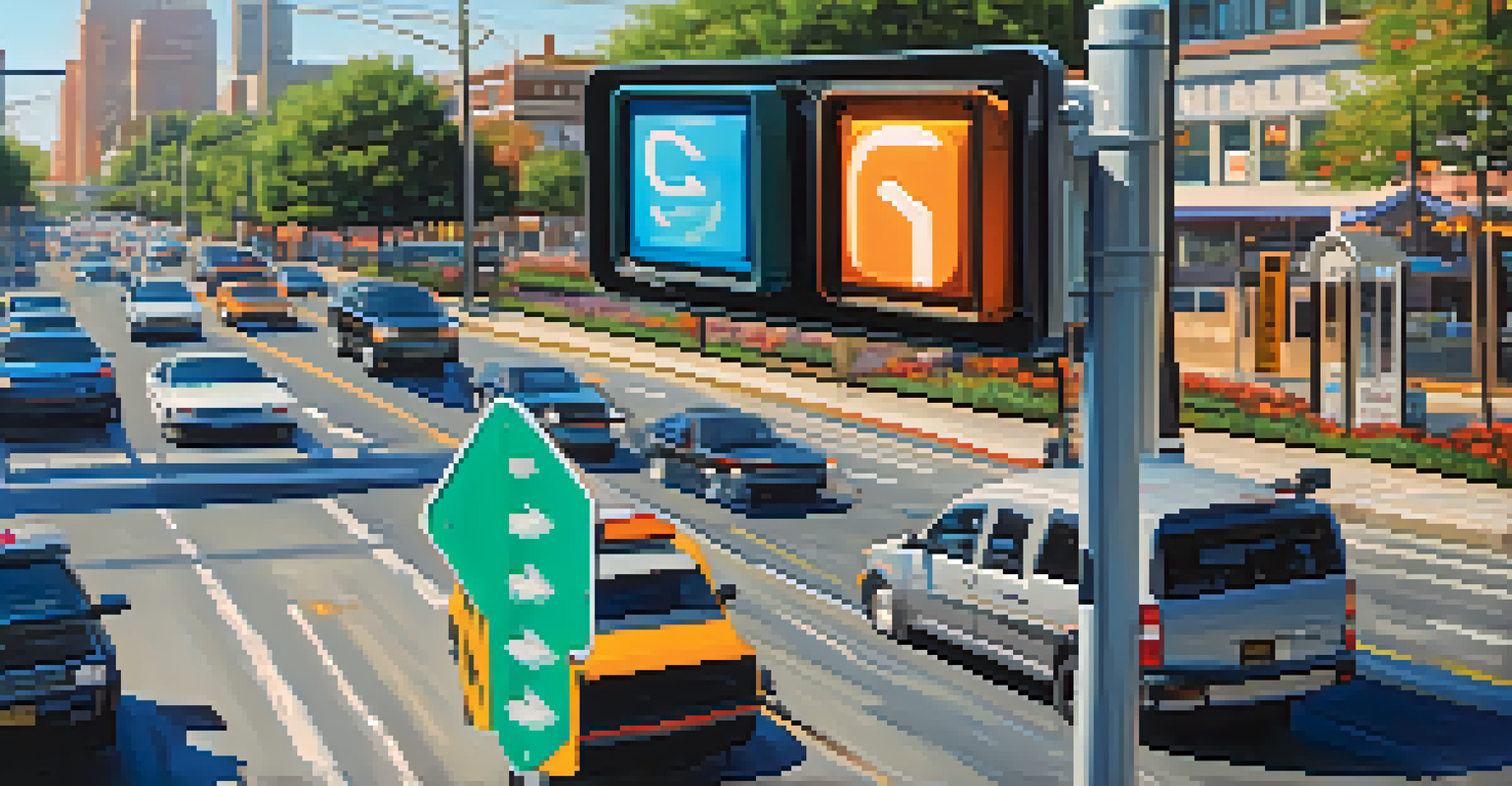Future Projects for Georgia's Transportation Infrastructure

Introduction to Georgia's Transportation Needs
Georgia's transportation infrastructure is at a critical juncture, requiring significant upgrades to meet growing demands. With bustling urban areas and expanding suburban regions, the state faces increasing traffic congestion and wear on existing roads. Addressing these challenges is essential for maintaining economic growth and improving quality of life for residents.
Investing in public transit is not just about moving people; it's about building communities.
The state's strategic vision involves not only repairing aging infrastructure but also innovating for future needs. By investing in modern transportation solutions, Georgia aims to create a more efficient and sustainable system. This vision will help alleviate congestion while enhancing connectivity across the state.
In this article, we'll explore some key projects that are set to reshape Georgia's transportation landscape. From road improvements to public transit expansions, these initiatives are designed to tackle current issues while planning for future growth.
Expansion of Public Transit Systems
One of the most significant future projects is the expansion of public transit systems throughout Georgia. Cities like Atlanta are prioritizing the enhancement of their public transportation networks, making them more accessible and efficient for residents. This expansion includes adding new bus routes, improving existing rail services, and integrating technology to streamline operations.

Public transit expansion aims to reduce reliance on personal vehicles, thereby alleviating road congestion and lowering carbon emissions. By making public transportation a more viable option, Georgia hopes to encourage more residents to leave their cars at home. This shift not only benefits the environment but also enhances urban mobility and accessibility.
Public Transit Expansion Boosts Mobility
Georgia is enhancing public transit systems to reduce congestion, promote sustainability, and stimulate local economies.
Moreover, investing in public transit can stimulate local economies by connecting communities to job opportunities and essential services. As more people utilize transit options, businesses are likely to thrive, leading to a more vibrant economic landscape.
Highway and Roadway Improvements
Georgia's highways and roadways are crucial for facilitating trade and travel, and numerous improvement projects are on the horizon. The state plans to upgrade key corridors, enhance traffic flow, and improve safety measures to address the growing volume of vehicles. These improvements are vital for reducing travel times and decreasing accident rates.
The roads and bridges we build today are the arteries of our economy tomorrow.
Additionally, the focus will be on modernizing infrastructure to accommodate future traffic demands. This includes the implementation of smart traffic management systems that use real-time data to optimize signal timings and reduce congestion. Such technology can make a significant difference, particularly in densely populated areas.
By prioritizing roadway enhancements, Georgia aims to create a safer, more efficient transportation network that supports both local residents and interstate commerce. As these projects unfold, the state's economy is expected to benefit from improved access and mobility.
Innovative Transportation Technology Integration
As part of its future projects, Georgia is embracing innovative transportation technologies to enhance safety and efficiency. This includes the introduction of smart traffic signals, autonomous vehicle infrastructure, and real-time traffic monitoring systems. These advancements are designed to streamline traffic flow and improve the overall commuting experience.
Integrating technology into the transportation infrastructure not only enhances safety but also helps in managing congestion more effectively. For instance, real-time updates can inform drivers of traffic conditions, allowing them to make better route choices. This proactive approach to traffic management can significantly reduce travel times.
Innovative Technology Improves Safety
The state is integrating advanced technologies like smart traffic signals and real-time monitoring to enhance safety and efficiency in transportation.
Moreover, the incorporation of technology also paves the way for future innovations, such as autonomous vehicles. As these technologies evolve, Georgia is positioning itself to be at the forefront of transportation advancements, ensuring that its infrastructure remains relevant and efficient.
Bicycle and Pedestrian Infrastructure Development
Recognizing the importance of non-motorized transportation, Georgia is planning extensive developments for bicycle and pedestrian infrastructure. This includes the construction of dedicated bike lanes, pedestrian walkways, and improved access to public transit stations. Such initiatives encourage healthier and more environmentally friendly commuting options.
Creating a robust network for cyclists and pedestrians not only promotes active lifestyles but also enhances community connectivity. Well-designed pathways can link neighborhoods with parks, schools, and commercial areas, making it easier for residents to navigate without a car. This approach fosters a sense of community and encourages local engagement.
Furthermore, investing in bicycle and pedestrian infrastructure can reduce traffic congestion by providing alternatives to driving. As more people choose to bike or walk, the demand on roadways decreases, leading to a more balanced transportation system.
Sustainable Practices in Transportation Projects
Sustainability is becoming a cornerstone of Georgia's transportation projects, with a focus on eco-friendly practices and materials. The state is committed to minimizing environmental impact while enhancing infrastructure. This includes using recycled materials in road construction and incorporating green spaces into urban planning.
Additionally, the promotion of electric vehicle (EV) infrastructure is part of this sustainable approach. By installing more EV charging stations, Georgia aims to encourage the adoption of electric vehicles, which can significantly reduce greenhouse gas emissions. This initiative aligns with broader environmental goals and supports a transition to cleaner transportation options.
Sustainable Practices Shape Infrastructure
Georgia is prioritizing eco-friendly practices in transportation projects, including the use of recycled materials and promoting electric vehicle infrastructure.
Sustainable practices not only benefit the environment but also create healthier communities. By prioritizing green initiatives, Georgia is setting an example for other states to follow, demonstrating that transportation infrastructure can evolve without compromising ecological integrity.
Funding and Investment for Future Projects
Securing funding for transportation infrastructure projects is crucial for their successful implementation. Georgia is exploring various avenues, including federal grants, public-private partnerships, and state funding initiatives. This multi-faceted approach ensures that resources are available to support the ambitious plans laid out for the future.
Public engagement and transparency in the funding process are also essential. By involving residents in discussions about funding priorities, the state can better align projects with community needs and expectations. This collaborative approach fosters trust and encourages public support for transportation initiatives.

As investments flow into these projects, they are expected to generate economic benefits, including job creation and improved accessibility. By prioritizing funding for transportation, Georgia is not just investing in infrastructure but also in the future prosperity of its communities.
Conclusion: A Roadmap for Georgia's Future
The future projects for Georgia's transportation infrastructure represent a comprehensive roadmap for progress. By prioritizing public transit expansion, roadway improvements, and sustainable practices, the state is taking significant steps towards a more efficient transportation system. These initiatives are designed to address current challenges while preparing for future growth.
As Georgia moves forward with these projects, the focus will remain on enhancing connectivity, safety, and environmental sustainability. The integration of technology and community engagement will be key components in ensuring these plans are successfully executed. The overall goal is to create a transportation network that meets the needs of all residents.
In conclusion, the future of Georgia's transportation infrastructure looks promising. With thoughtful planning and investment, the state is on track to build a resilient and adaptive transportation system that will serve its citizens for generations to come.